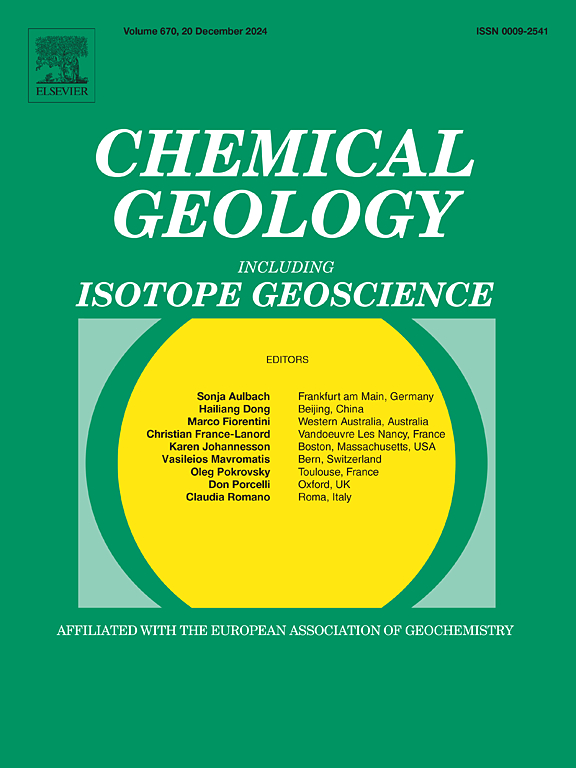生物地球化学氧化还原过程中锂和铬同位素的潜在途径:来自希腊喀斯特型红土的启示
IF 3.6
2区 地球科学
Q1 GEOCHEMISTRY & GEOPHYSICS
引用次数: 0
摘要
本研究的重点是未勘探的关键和战略元素锂(Li)在希腊中部蛇绿岩橄榄岩和风化产物(红土、蚀变超镁质岩石)、受影响土壤和地下水中的分布。将所提供的Li等微量元素数据与现有的cr同位素组成相结合,作为从岩浆源到这些风化产物的氧化还原反应及其地球化学循环的示踪剂,旨在确定有利条件和潜在途径。所有样品均含有有机质,但铝土矿红土中有机质含量较高。相关还原性微生物在Al-Fe-氧化物上催化氧化还原反应的活性可能导致Fe(III)还原为可溶性Fe(II),为铁的浸出和Al和Li的增加提供了途径,Al和Li之间存在良好的正相关关系(r = 0.85)。然而,铁的部分再沉积是明显的,纳米颗粒球状和/或细菌形态的黄铁矿的出现。由于Cr主要以Cr(III)的形式存在于铬铁矿、橄榄石、蛇纹石中,在氧化条件下,Cr可能被释放氧化为Cr(VI)。希腊铬铁矿δ53Cr值变化虽小,但可探测到,变化范围从最负的微负到正,可能是岩浆期后地幔作用或交代作用的差异所致。与铬铁矿中非常小的变化相比,C. Greece的Fe- ni -红土、风化岩和地下水中记录的δ53Cr值的变化要大得多,并且与Cr(VI)呈负相关,支持Fe(II)、有机物、硫化物或微生物将Cr(VI)还原回Cr(III)。然而,渗滤液中的δ53Cr值比地下水中的δ53Cr值要低,这可能是由于Cr(VI)的减少及其以Cr(OH)3的形式沉淀,以及/或吸附和生物积累过程。受Cr(VI)污染的沿海地区地下水中Li浓度升高可能反映了海水的入侵,表明由于Cr(VI)的潜在稳定性,Cr(VI)向Cr(III)的还原受到抑制。这可以应用于土壤-地下水-植物/作物系统,使用适当的技术来促进Cr(VI)的减少和保护食物链。本文章由计算机程序翻译,如有差异,请以英文原文为准。
Potential pathways for lithium and Cr-isotopes during biogeochemical redox processes: Insights from karst-type laterites of Greece
The present study is focused on the distribution of unexplored critical and strategic element lithium (Li) in ophiolitic peridotites and weathered products (laterites, altered ultramafic rocks), affected soil and groundwater from Central Greece. The provided Li and other trace elements data are combined with available Cr-isotope compositions as tracers for redox reactions and their geochemical cycling from the magmatic source to these weathered products, aiming to define favorable conditions and potential pathways. All samples contain organic matter, but it is higher in bauxite laterites. The activity of the associated reducing microorganisms, catalyzing redox reactions, on Al-Fe-oxides may result in the reduction of the Fe(III) to soluble Fe(II), providing pathways for the iron leaching and the increase of Al and Li, as is exemplified by a good positive correlation between Al and Li (r = 0.85). However, partly re-deposition of iron is obvious by the occurrence of nanoparticulate spheroidal and/or bacterio-morphic pyrite. Given that the Cr occurs mainly as Cr(III) in chromite, olivine, serpentine, it may be released and oxidized to Cr(VI), under oxidizing conditions. The variations in the δ53Cr values in chromitites from Greece are small but detectable, ranging from the most negative slightly negative to positive, due probably to differences in the mantle processes or metasomatism, during post-magmatic stages. The variations of the δ53Cr values recorded in Fe-Ni-laterites, weathered rocks and groundwater from C. Greece are much wider compared to a very small variation in chromitites and show a negative correlation versus Cr(VI), supporting the post-mobilization reduction of Cr(VI) back to Cr(III) by Fe(II), organic matter, sulfides or microorganisms. However, δ53Cr values in the leachates are lower compared to these in groundwater, due probably to the reduction of Cr(VI) and its precipitation as Cr(OH)3, and/or the adsorption and bio-accumulation processes. Elevated Li concentrations in groundwater from coastal areas contaminated by Cr(VI) may reflect the intrusion of seawater, suggesting that the reduction of Cr(VI) to Cr(III) is inhibited, due to the potential stability of Cr(VI). This may be applied to the soil-groundwater-plant/crops system, using appropriate techniques to facilitate the reduction of Cr(VI) and protect food chain.
求助全文
通过发布文献求助,成功后即可免费获取论文全文。
去求助
来源期刊

Chemical Geology
地学-地球化学与地球物理
CiteScore
7.20
自引率
10.30%
发文量
374
审稿时长
3.6 months
期刊介绍:
Chemical Geology is an international journal that publishes original research papers on isotopic and elemental geochemistry, geochronology and cosmochemistry.
The Journal focuses on chemical processes in igneous, metamorphic, and sedimentary petrology, low- and high-temperature aqueous solutions, biogeochemistry, the environment and cosmochemistry.
Papers that are field, experimentally, or computationally based are appropriate if they are of broad international interest. The Journal generally does not publish papers that are primarily of regional or local interest, or which are primarily focused on remediation and applied geochemistry.
The Journal also welcomes innovative papers dealing with significant analytical advances that are of wide interest in the community and extend significantly beyond the scope of what would be included in the methods section of a standard research paper.
 求助内容:
求助内容: 应助结果提醒方式:
应助结果提醒方式:


